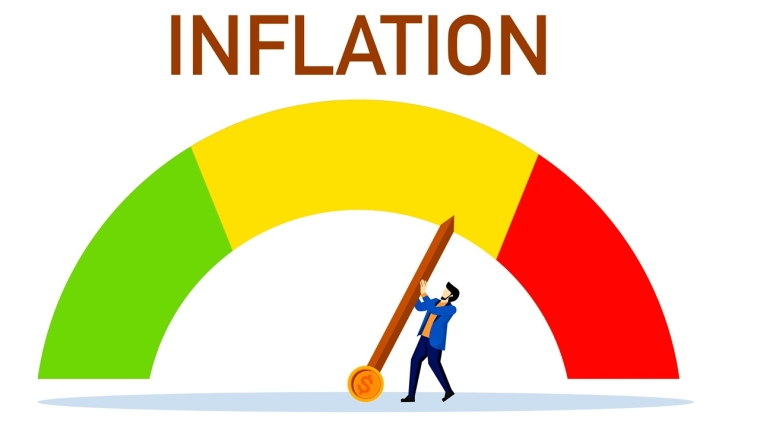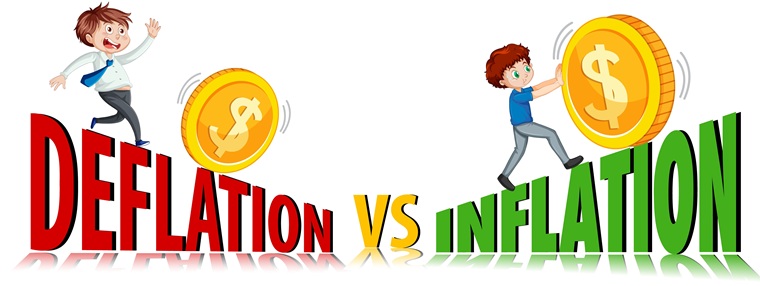
Well, exactly a year after declaring 'victory' over inflation, here we are wondering if we've been 'defeated' again!
Okay, perhaps 'defeat' would be more than a slight exaggeration, but the September quarter Consumers Price Index figures due to be released this coming Monday (October 20) represent an important moment nevertheless in our battle with the inflation beastie.
The big question is, will the announced annual inflation rate number hit, or exceed, 3%?
What's in a number? Well potentially quite a lot if it's a number over 3, and we are discussing inflation.
Remember, the Reserve Bank (RBNZ) is charged with achieving inflation between 1% and 3% and it explicitly targets 2%. If inflation misbehaves, we get higher interest rates. So, this stuff matters.
After global supply chains broke during the pandemic we saw inflation take off with the proverbial hiss and a roar. In the March quarter 2021 our annual inflation was 1.5%. By June 2021 it had rocketed to 3.3%. A year later it hit the peak in the cycle of 7.3%. It was inflation of a magnitude many people had not seen in their lives up to that point.
In the meantime, the RBNZ got busy, cranking the Official Cash Rate up from the pandemic emergency setting of 0.25%, eventually as high as 5.5% and giving those with mortgages a squeeze in the financials.
Good about the falling inflation, shame about the recession
Inflation took its good time to come down, but finally broke back into the 1%-3% range with a 2.2% annual reading as of the September 2024 quarter. A good news story, no doubt, even though we went through a recession to get there.
But whether we regarded this 'victory' as sweet or not, it was fairly short-lived. Since then inflation's been edging back up. It was 2.7% as of the June quarter, now quite well above the RBNZ's targeted 2% level and pushing up towards the top of that 1%-3% zone. The RBNZ expects that inflation DID reach 3% as of the September quarter, as do major bank economists, economists at the country's largest bank, ANZ, reckon it hit 3.1%.
Now, we might think with inflation moving up again that the OCR should be on the rise too. But very much the opposite is happening, with the RBNZ this month throwing in a jumbo 50 point cut taking it down to 2.5%, and with a further 25 point cut down to 2.25% widely anticipated.

The RBNZ has become focused on the way the economy's apparent recovery fizzled out in the June quarter - a fact ultimately highlighted by a 0.9% drop in GDP for the quarter (even if those figures rather overstated the decline). And indeed high frequency data for the month of September suggests that after a pick up in July and August our economy again went cold in September.
The Reserve Bank's worries
The RBNZ sees "significant" spare capacity in the economy and is clearly bothered. The Bank's Monetary Policy Committee, in discussing the case for reducing the OCR by 50 basis points on October 8, emphasised prolonged spare capacity "and the associated downside risk to medium-term activity and inflation".
So, the RBNZ is focused on getting the economy to grow at the moment and is not too worried about inflation. This is some of the specific comment it made on the subject in the record of meeting for the OCR-setting Monetary Policy Committee on October 8:
The Committee noted that headline inflation is projected to have reached 3.0% in the September 2025 quarter, reflecting large increases in administered prices, food prices, and the prices of other tradable goods and services. Excluding the influence of administered prices, quarterly non-tradables inflation has continued to decline and is at levels consistent with price stability.
But wait...there's more, this from the RBNZ's media release:
Annual consumers price index inflation is currently around the top of the Monetary Policy Committee’s 1% to 3% target band. However, with spare capacity in the economy, inflation is expected to return to around the 2% target mid-point over the first half of 2026.
But then this, again from the MPC record of meeting:
The Committee discussed upside risks to domestic inflation. Businesses continue to face cost pressures from administered prices, such as local council rates, and some energy charges. The Committee’s central expectation is that inflation reached 3.0% in the September quarter. Given the two-sided uncertainty around any forecast, there is a material possibility that September quarter inflation was outside the target band. If inflation was to remain higher for longer than expected, there is a risk that this influences inflation expectations and wage- and price-setting behaviour over the medium term.
I include all that here, because to me those above comments rather disconcertingly offer two discrete, and indeed, opposing, views: Firstly, hey, it's okay, this inflation is a short run thing that will fizzle out. Secondly, well, hmm, if this inflation goes longer than we think, it could be a problem...
Come on folks either this is a short run spike in inflation...or it isn't. Which one? I think the RBNZ's hedging of its language points to its own nervousness. It thinks/hopes this inflation spike is temporary, but what if ain't?
I still have fresh memories of how the pandemic spike in inflation was apparently going to be temporary. Our annual CPI ended up being outside of the 1% to 3% range for three years. That's not temporary.
Keeping the OCR cut on track
Assuming the coming week's CPI figure does come in at around 3% (or maybe even a touch below) then any potential problem is pushed at least a few months down the track. The narrative of a short-run inflationary spike will still be intact and we can carry on as we are at the moment - and the OCR will be cut further at the last review for 2025 on November 26.
A figure above 3% - IE taking us out of the 1%-3% range again - could be more problematic. How relaxed could the RBNZ continue to be if the inflation rate continues to sit outside of the range?

As ever, a key focus from the figure to be announced on Monday will be the composition of it. Where is it coming from? Is it domestically sourced? Or is it largely overseas sourced?
Well the expectation is for significantly higher offshore-sourced inflation compared with recent times, with domestic inflation pressures still easing (from previously stubbornly high levels). If that proves to be the case this would be supportive of the 'temporary' inflation narrative.
And indeed, the Selected Price Indexes for September, released on Thursday (October 16) were very much supportive of the idea that domestic inflation is still slowing, with monthly food prices down for the first time since February after sharp increases in recent months, while annual growth in rents, at just 1.8%, was the slowest since 2011.
A soggy September
All the available data I've seen on September suggests it was another soggy month indeed for our economy - and that doesn't suggest folk will be able to increase prices meaningfully in the short run, so, theoretically our domestic inflation should continue to ease.
But of course, depending on how all the 'tradable' (IE overseas sourced) portions of the CPI turn out, we could still end up with an annual inflation rate in excess of 3.0% as of the September quarter.
And the problem with any rise in inflation, and if it is sustained for some time, is the impact it could have on inflationary expectations, the self-fulfilling expectations that see people actually driving up inflation because they are anticipating...inflation.
So, fingers crossed everybody's right about this latest bout of 'temporary' inflation. We 'beat' inflation before at a considerable cost to our economy. It would be nice to think this new wave of inflation might just clear off of its own accord this time!
*This article was first published in our email for paying subscribers early on Friday morning. See here for more details and how to subscribe.
15 Comments
The two RBNZ positions - that inflation is not a threat, but CPI might go up - are compatible to them.
They live in the wacky world of inflation expectations and wage-price spirals. They think that the economy has enough spare capacity, aka loads of people desperately wanting work, so higher input costs and some extra demand will not set wages on fire, which would then feed back into prices creating a spiral.
In the real world, the vast majority of our businesses run on a low competition, cost + margin model. If their input costs go up, so do their prices. If input costs go down, prices stay still, or drop in competitive sectors with varying lags (depending on the level of competition - eg urban fuel stations).
The only sector that has taken a margin haircut over the last couple of years is retail. Other sectors have simply downsized to reflect lower demand and held their margins steady. This has manifested as closing businesses, fewer staff, less opening hours etc. Lower demand has played hardly any role in moderating inflation.
Yes, seriously... when people have less money to spend, they just buy less discretionary stuff and sectors downsize to reflect the lower demand. Rent is a partial exception to that rule given it is less substitutable (although plenty of people are living back with parents or in tents and cars).
Once you see prices in the NZ economy as a simple passthrough of the costs of imported goods and services, wages, debt servicing costs, and profits (most of which is rent paid to onshore and offshore shareholders and savers), it all makes much more sense, and it makes monetary policy look impotent.
Consider this graph. See how imported prices pushed up domestic prices, and how higher interest costs kept living costs higher for longer? See how wages responded to higher cost of living and pushed slightly on prices? See how price rises moderated as imported input cost changes went negative? Would a lower or 'higher for longer' OCR have made any difference here? And, if so, given debt servicing costs are a major input cost for NZ businesses, in which direction would a higher OCR have pushed 'inflation' ?
If we genuinely wanted a lower cost of living and price stability, we would study the flow through of input costs and work out how to insulate ourselves from global price instability. Oil prices are an obvious place to start. We would also look at how Denmark and others keep a lid on prices by going hard on profiteering in low competition sectors. We would also absolutely not leave natural monopolies like energy to the market.
Thank you for taking the time to post this. Makes me shake my head in awe. I do wonder if the folks working on these decisions from the inside, have fallen capture to a sort of 'the king has no clothes' group think, and no one wants to buck 'this is how its always been done' mentat.
So the fact that the RBNZ lowered the OCR and the economy went bananas and we got inflation, then they increased the OCR and the economy went to crap and inflation disappeared, is yet another fluke?
It’s much easier for businesses to increase prices when the economy is humming. I don’t think they are cost plus at all, and if so it’s a big plus. Take a plumber for example, the wholesale cost of the pipe is a tiny fraction of their bill. If they are in demand they give you a stupid quote, often you have no other option. If the economy has cooled all of a sudden the quote makes more sense.
RBNZ lowered the OCR and inflated asset prices. We got exactly how much 'inflation' in the real economy as you would expect given the change in input costs. For example, we import a third of our consumption by value, so when our import prices jumpted up 24% in a year, we got inflation of over 7%. Our 'inflation' lasted longer because wages responded to the shift in the price level, and higher debt-servicing costs prolonged the input cost pressures on businesses. I genuinely don't think the OCR made any notable difference at all to the price level. We adjusted to the global shift. All countries did / had to - whether they hiked rates or not.
I don't doubt that businesses can increase margin in the good times, but the macro business data shows clearly that margins only made a difference on the upside during 2020 and 2021 (when wholesalers cleaned up as import prices fell). Operating margins have been steady across most sectors (with the exception of retail, as I said above).
I still think you underestimate the extent to which inflation, including import prices, were demand driven. During the pandemic there was exceptionally high local and global demand for durables, due to monetary stimulus everywhere, and importantly a demand shift due to reduced opportunities to spend on services etc. That's where the price increases came from. It didn't suddenly need 25% more inputs (labour and materials) to produce that stuff. If the cost of inputs went up, it's because demand driven inflation tends to carry up the chain and get mostly captured by those who control the most basic, unreplaceable inputs - that's not your local retailer, it's people who control natural resources or have monopolised a bottleneck in a supply chain.
It looks import driven to us because that all happens offshore.
I do agree with you that businesses will often downsize and hold margin, rather than maintain size and cut margins.
That is an excellent and very clear explanation.
The current government stripped the RBNZ of it's dual mandate to focus solely on inflation so why all the hand wringing about 'spare capacity' and unemployment? The RBNZ have to believe the NZ economy is going to continue to contract and bring down inflation through falling demand. This suggests that medium term forecasts are seeing a very weak economy - one that is weak enough to cause disinflation.
However, the RBNZ are walking into a trap - if the OCR keeps falling this will weaken the value of the NZ dollar and this will make imports more expensive - an upward inflation pressure. In their efforts to prevent deflation they are generating stagflation.
But will the NZD weaken any more than it otherwise would have without the lowered OCR?...another misconception?
The current government stripped the RBNZ of it's dual mandate to focus solely on inflation
Yes, as was their main mandate until 2018 when the employment remit was added for the RBNZ. It was wholly contradictory to inflation given the system relies on spare capacity to keep wages low and this inflation pressures down. How else can the elite continue to be renteirs to save on tax and succeed at the expense of others.
Stagflation. Well done NZ. No other country has managed to do this post COVID - it takes a very special type of economic management and a stern belief in the rightness of recessions to clean up the wasteful and bad spending in the economy.
There is a key macroeconomic tool that is completely missing in action - counter-cyclical fiscal policy. The RBNZ cannot restart the economy on its own.
Privatise the profits (higher untaxed house prices and bank bonuses) and socialise the losses (inflation driving cost of living to every one). If the govt keeps this up, the swing vote will go back to the loony bin left.
The main culprits this time around:
Food, power, rates, ACC levies.
Either monopolies or government, with price-setting capabilities.
Keeping a lid on this lot is the problem.
It will still lead to another round of wage and price spiral and more key taxpayers leaving to Straya.
Power? The stuff has been free for weeks. $0.00001 kWh is cheap at twice the price.
https://app.em6.co.nz/?stackedgwap.filter.gridZone=15&stackedgwap.filte…

We welcome your comments below. If you are not already registered, please register to comment.
Remember we welcome robust, respectful and insightful debate. We don't welcome abusive or defamatory comments and will de-register those repeatedly making such comments. Our current comment policy is here.